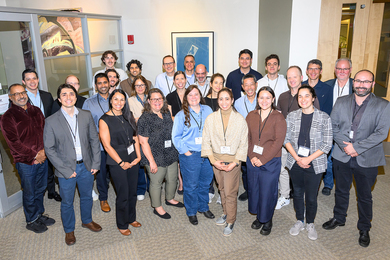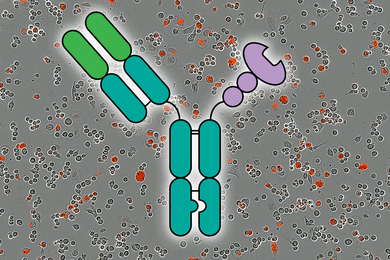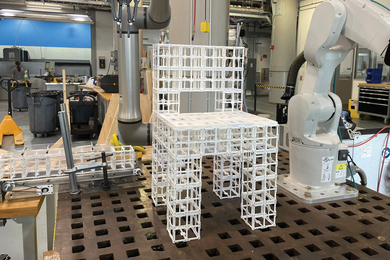CAMBRIDGE, Mass. -- MIT researchers report a powerful new tool for studying complex sugars, or polysaccharides, materials that are the focus of a hot new field in biology and that have recently been shown to play key roles in processes from viral infection to tissue development. The tool, which the researchers will describe in the October 15 issue of Science, is a technique for determining the linear order of building blocks in complex sugars.
Similar sequencing techniques for DNA and proteins have allowed scientists to understand the functions of those materials -- and have led to Nobel prizes and been instrumental in shaping the biotechnology industry.
Among other advantages, the new sequencing technique could be automated and is extremely fast. The researchers took one day to sequence an important sugar whose order of building blocks had already been partially deciphered by others -- over several months.
BURGEONING FIELD
The work is particularly key to the burgeoning field of glycosaminoglycans, or GAGs, complex sugars in the web of material that surrounds cells. "Historically, these sugars were thought to be useless inert material outside cells," said Ram Sasisekharan, an assistant professor in the Division of Bioengineering and Environmental Health (BEH) and leader of the MIT team.
However, he said, "work over the last few years has changed this notion. Now they're known to be very active molecules that orchestrate how signals from outside the cell are processed and perceived by the cell." Professor Sasisekharan's laboratory is responsible for some of these insights.
Yet "our understanding of complex sugars to date is only the tip of the iceberg," Professor Sasisekharan said. "We are where scientists were in the early stages for nucleic acids (the building blocks of DNA)."
That's due in part to the lack of an easy way to sequence the sugars. "Once you have the sequence of building blocks for a given polysaccharide, you can start cracking the biological function of that sugar in the tissue," said Professor Sasisekharan.
So Professor Sasisekharan set about solving that problem with Ganesh Venkataraman, a research associate in the Harvard-MIT Division of Health Sciences and Technology, and BEH graduate students Zachary Shriver and Rahul Raman of Professor Sasisekharan's laboratory.
The task was daunting. The sugars they wanted to sequence are complex. There are four basic building blocks for DNA, 20 for proteins, and 32 for just one family of sugar (a type of GAG known as heparin/heparin sulfate-like glycosaminoglycans, or HLGAGs). A sugar eight building blocks long in that family could have over a million possible sequences. "HLGAG sugars are the most information-dense biopolymer found in nature," Professor Sasisekharan said.
MIT APPROACH
After several late-night sessions on how to tackle the problem, a two-pronged approach emerged. First, the team developed a unique code for each of the 32 HLGAG building blocks (they focused on HLGAG, but the technique is applicable to other sugars as well). Each code is not only easily read by computers, but also indicates specific characteristics of each building block (for example, the number of key chemical groups in each).
"Now I have a sample in front of me, and the objective is to know how those 32 blocks are arranged," said Dr. Venkataraman. The next step: a compositional analysis in which the researchers break the sample down into its individual building blocks and count how many of each it contains. They identify each building block by its mass, which is in turn determined by a mass spectrometer, the second key part of the work.
With the list of building blocks (specifically, their codes) for a given sample in hand, "We feed this information into the computer and ask it to generate a list of all possible sequences that satisfy the overall composition," Dr. Venkataraman said. "The computer chugs through it and gives us one big number," he continued. "We now know that the correct sequence is among the ones listed. But we have to narrow the search. We do this by a process of elimination."
To that end the team uses enzymatic and chemical techniques to cut a second, intact sample into smaller and smaller pieces. Because these techniques cut the sugar at specific sites, the researchers know, for example, what building block each piece begins and ends with. In addition, the mass of each of these smaller pieces is determined, which gives the number and kind of building blocks in each. Repeating this process for smaller and smaller pieces eventually gives the correct sequence.
MULTIDISCIPLINARY EFFORT
The researchers emphasize that the development of the new sequencing technique involved the integration of very different fields -- a hallmark of the new bioengineering initiative at MIT. Team members have backgrounds in the biological sciences, chemical engineering, chemistry, and computer science. "I think we were effective in integrating our different perspectives, as was crucial for tackling such a complex problem," Professor Sasisekharan said.
"The problem was difficult but challenging. We came up with some good ideas that provided us with powerful tools for exciting future research in this emerging area," he concluded.
The researchers have applied for a patent on the work, which was supported in part by MIT and the NIH. Professor Sasisekharan has received a number of awards this year alone for this and related work. They include the CaPCure Foundation Research Award, the Beckman Foundation Young Investigator Award, the Burroughs Wellcome Fund Young Investigator Award in Pharmacological Sciences, and the Edgerly Science Partnership Award.





